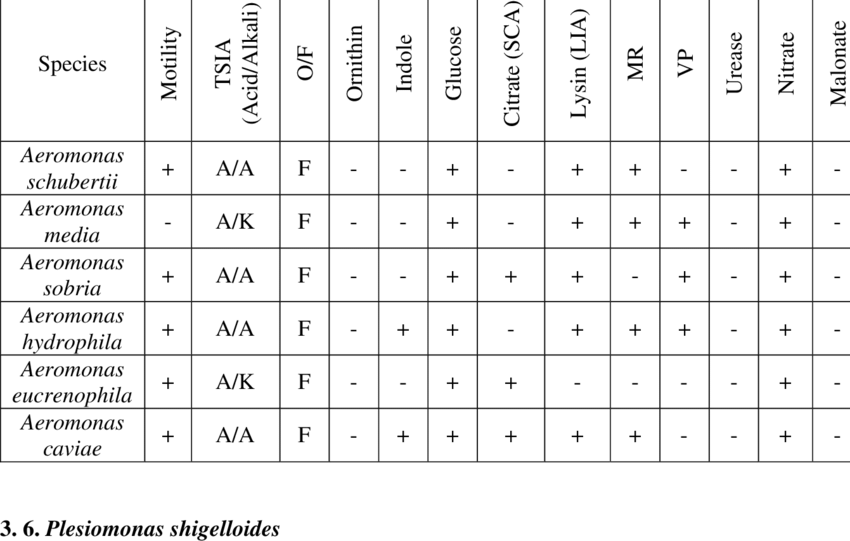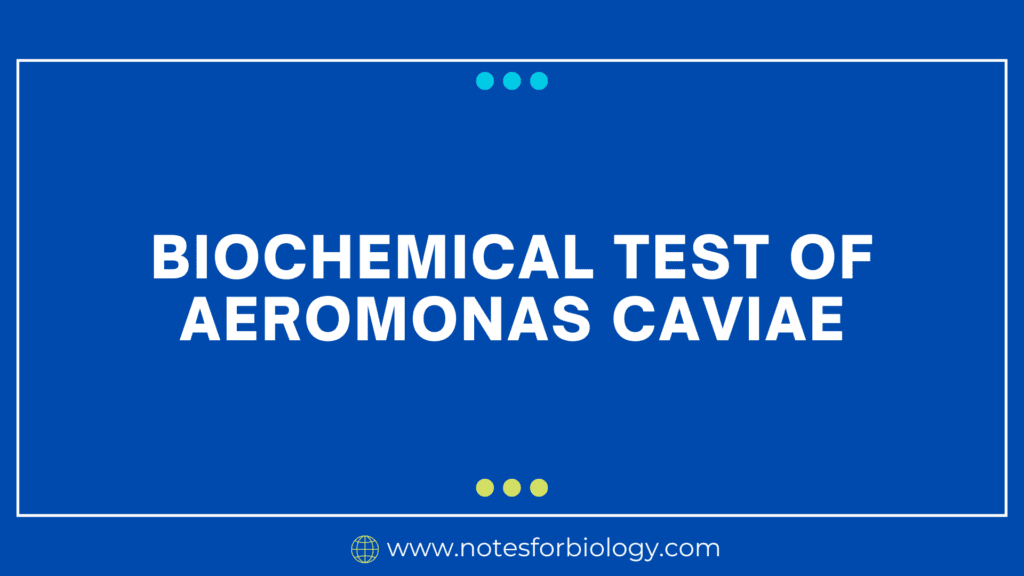A gram-negative, rod-shaped bacteria called Aeromonas caviae is frequently found in aquatic settings. It is well known to cause a wide range of illnesses in people, including wound infections and gastroenteritis. To distinguish A. caviae from other Aeromonas species and similar bacteria, biochemical testing is essential. The main biochemical tests for identifying A. caviae will be discussed in this essay, with an emphasis on the concepts, procedures, and importance of each test.
Table of Contents
Key Test of Aeromonas caviae
- D-sorbitol: A. hydrophila is not able to ferment D-sorbitol, although Aeromonas caviae can. This is one of the main characteristics that set these two closely related species apart.
- Citrate: While A. hydrophila usually cannot grow on citrate agar, A. caviae can. This aids in their differentiation even further.
- DL-Lactate: Certain strains of A. hydrophila are unable to use DL-lactate as a carbon source, although Aeromonas caviae can. This could be one more thing that sets you apart.
1. Oxidase Test
One of the initial assays used to detect Aeromonas caviae is the oxidase test. Cytochrome C Oxidase is an enzyme that is part of the electron transport chain, and this test finds it. Aeromonas species that have this enzyme, such as Aeromonas caviae, are oxidase-positive.
Method:
- A little sample of the bacterial colony is taken using a sterile swab.
- The oxidase test strip or reagent (which often contains tetramethyl-p-phenylenediamine) is then touched with the swab.
- In 10 to 30 seconds, the emergence of a dark purple color indicates a successful outcome.
2. Catalase Test
The catalase test determines whether the enzyme catalase is present. Catalase breaks down hydrogen peroxide into oxygen and water. Similar to other species of Aeromonas, Aeromonas caviae is catalase-positive.
Method:
- On a glass slide, a drop of hydrogen peroxide is put.
- Using an inoculating loop, a tiny portion of the bacterial culture is moved to the slide.
- The formation of bubbles signifies a successful outcome.
3. Indole Test
The indole test determines whether an organism can synthesis indole from tryptophan, an amino acid. Usually, Aeromonas caviae is indole-positive.
Method:
- After being added to tryptone broth, the bacteria is cultured for 24 to 48 hours at 35 to 37°C.
- Kovac’s reagent is added to the broth following incubation.
- A positive outcome is shown by a red ring at the surface.
4. Methyl Red (MR) and Voges-Proskauer (VP) Tests
These tests evaluate the kinds of fermentation products that the organism produces and are a component of the IMViC series.
MR Test:
- After being injected into MR-VP broth, the bacteria is left to incubate for 48 hours.
- A few drops of methyl red indicator are added following incubation.
- A favorable outcome, denoting the generation of stable acid end products, is indicated by the color red.
VP Test:
- After incubation, potassium hydroxide and alpha-naphthol are added to the same MR-VP broth.
- Within 30 minutes, the color becomes red, indicating that acetoin is being produced. This is a good outcome.
5. Citrate Utilization Test
The ability of the organism to use citrate as its only carbon source is evaluated by the citrate test. Citric acid is usually utilizable by Aeromonas caviae.
Method:
- After being injected onto Simmon’s citrate agar slant, the bacteria is allowed to grow.
- A favorable outcome is indicated by a shift in hue from green to blue.
6. Urease Test
The urease test assesses an organism’s capacity to use the urease enzyme to hydrolyze urea. In general, Aeromonas caviae is urease-negative.
Method:
- Urea agar is inoculated with the bacterium.
- A shift in color to pink denotes a successful outcome.
7. Triple Sugar Iron (TSI) Agar Test
Based on their capacity to ferment glucose, lactose, and sucrose as well as generate hydrogen sulfide, bacteria are distinguished using the TSI test.
Method:
- Through stabbing the butt and streaking the slant, the bacteria is introduced into the TSI agar slant.
- Color changes and gas generation are used to interpret the data after incubation.
- Acid slant/acid butt (A/A) is a characteristic of A. caviae that does not produce hydrogen sulfide.
8. Gelatin Hydrolysis Test
The purpose of this test is to evaluate the organism’s capacity to create the enzyme gelatinase, which dissolves gelatin. Typically, Aeromonas caviaeis gelatinase-positive.
Method:
- After being injected into gelatin stab tubes, the bacteria is cultured.
- Positive outcome is indicated by the gelatin’s liquefaction.

Important Note
- Media: For oxidase and catalase testing, it is essential to utilize media free of fermentable carbohydrates because fermentation might produce false-negative findings. For this, MacConkey agar is frequently utilized.
- Commercial Identification techniques: Although certain commercial identification techniques are capable of distinguishing between distinct species of Aeromonas, their accuracy could be lacking.
Conclusion
To accurately identify Aeromonas caviae, biochemical assays are necessary. A thorough profile that sets A. caviae apart from other bacteria is provided by the combination of tests for oxidase, catalase, indole, MR-VP, citrate utilization, urease, TSI, and gelatin hydrolysis. For the clinical diagnosis and management of illnesses brought on by this bacterium, accurate identification is essential.
Frequently Asked Question(FAQ)
What biochemical test is used to identify Aeromonas species?
These were p-nitrophenyl-ß-D-galactopyranoside splitting and coumarate fermentation. The majority of the isolates across all species tested positive for the following additional tests: mannitol, maltose, trehalose, saccharose, and indole synthesis. For every isolate, urea hydrolysis yielded negative results.
How do you identify Aeromonas?
Method of Identification: Aeromonas species are catalase and oxidase positive facultative anaerobes.
What is the color of Aeromonas?
dark green colonies with dark centers
Related Article

